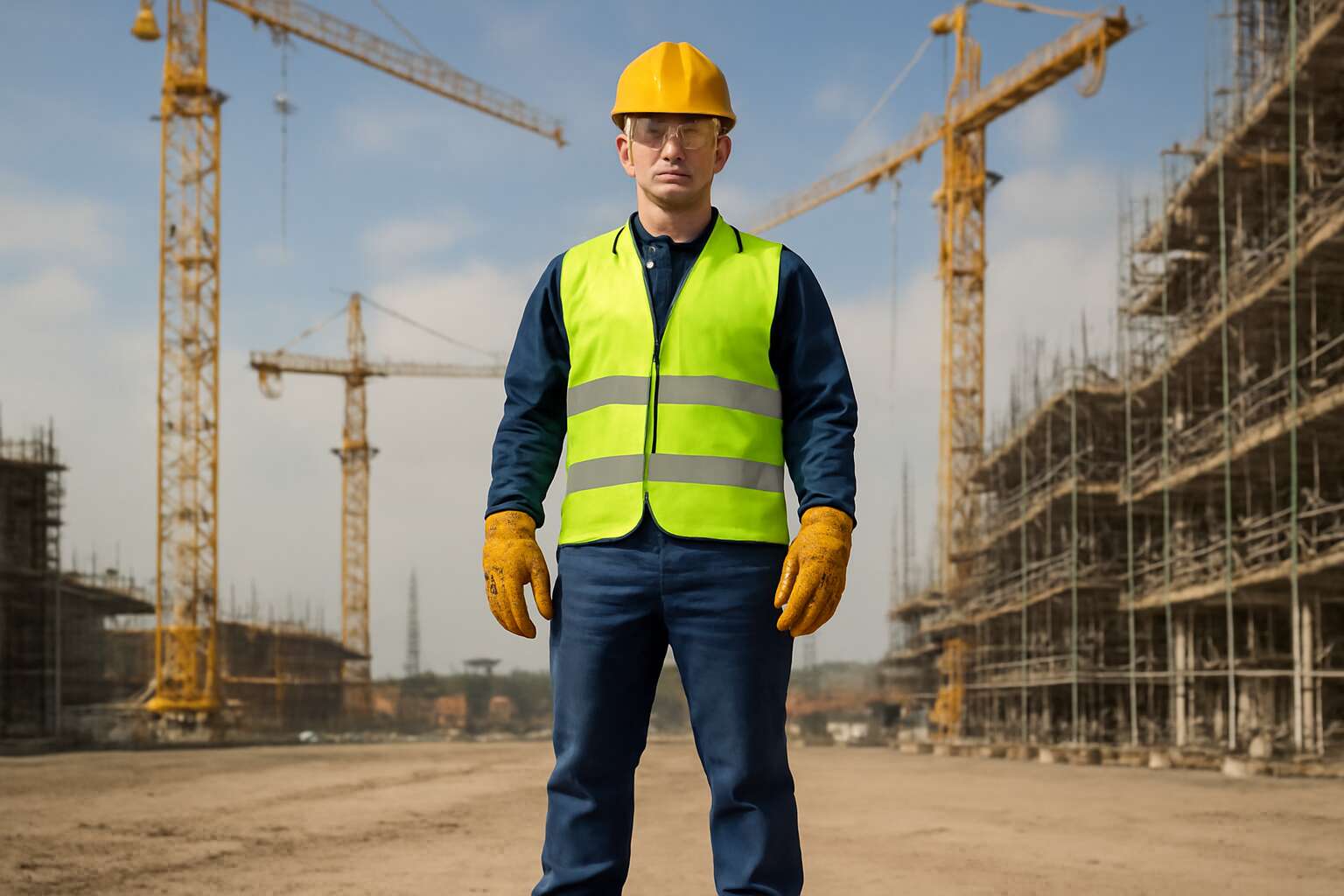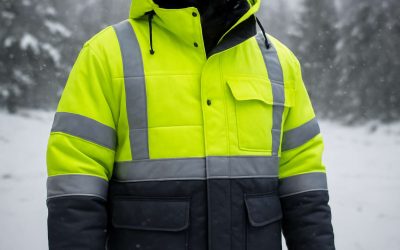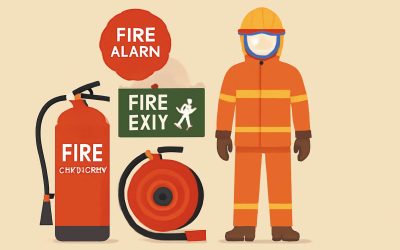Essential Personal Protective Equipment (PPE) for Construction Workers
Hard Hats and Helmets – Importance of head protection on construction sites, types of helmets, safety standards
Amidst the chaotic symphony of construction sites, one element remains unwavering in its importance—head protection. The stark reality is that head injuries account for a significant percentage of construction-related accidents, making PPE for construction an absolute necessity. Hard hats and helmets serve as the first line of defence, transforming raw strength into a barrier against falling debris, accidental bumps, and unforeseen hazards.
Construction helmets come in diverse forms, each tailored to meet specific safety standards while offering comfort and durability. From high-visibility designs to those with integrated face shields, these protective marvels are engineered to withstand the rigours of the construction environment. The safety standards governing these helmets—such as the South African SANS 50365—ensure that every piece of PPE for construction adheres to stringent quality benchmarks.
To truly grasp their significance, consider this: a hard hat can absorb the impact of a falling object, preventing a potential catastrophe. Whether it’s a basic model or a technologically advanced helmet with enhanced shock absorption, the core purpose remains unchanged—protecting the crown on which all else depends. In the realm of PPE for construction, headgear isn’t just an accessory; it’s a safeguard against the unpredictable fury of the construction universe.
Eye and Face Protection – Safety goggles, face shields, protecting against debris and chemical splashes
In the relentless world of construction, the danger isn’t always visible at first glance. Eye and face injuries account for a significant portion of workplace accidents, often caused by flying debris, chemical splashes, or sparks. That’s why robust eye and face protection are not just accessories—they are essential components of PPE for construction workers. When debris whizzes past at high velocity, only the right gear can prevent permanent damage or blindness.
Safety goggles and face shields serve different yet equally critical roles. Goggles provide a snug fit that keeps out tiny particles, while face shields offer full-face coverage against chemical splashes or molten metal splatters. The versatility of PPE for construction is evident in the range of protective gear designed to meet various hazards. For example, some face shields are equipped with anti-fog coatings and impact-resistant lenses, ensuring clear vision in demanding environments.
In high-risk zones, employing a combination of PPE—such as safety goggles paired with face shields—can be the difference between safety and catastrophe. Remember, construction sites are unpredictable, and safeguarding your workers’ eyesight is paramount. Investing in high-quality PPE for construction isn’t just compliance; it’s a commitment to preserving life and livelihood amidst the chaos.
Protective Clothing – High-visibility vests, safety jackets, flame-resistant clothing
Construction sites are a crucible of unpredictable hazards, where the stakes extend beyond mere productivity—they touch the core of human safety and dignity. Among the essential personal protective equipment (PPE) for construction, protective clothing plays a pivotal role in shielding workers from the elements and unforeseen dangers. High-visibility vests and safety jackets are not just about compliance; they are vital for ensuring workers remain visible amid the chaos of bustling sites. In South Africa, where diverse weather conditions and complex site operations prevail, choosing the right PPE for construction becomes a moral imperative.
Flame-resistant clothing further underscores the importance of safeguarding life. These garments serve as a barrier against sparks, molten metal, and electrical arcs—common threats in construction environments. For workers operating near electrical installations or welding zones, flame-resistant PPE creates a critical line of defense.
- High-visibility vests
- Safety jackets
- Flame-resistant clothing
are the backbone of comprehensive PPE for construction, providing both safety and peace of mind amid the chaos.
Ultimately, the moral obligation to protect construction workers necessitates investing in durable, reliable PPE. It’s a silent promise that safety remains at the heart of every project, no matter how arduous the task or how unpredictable the environment. Because at the end of the day, the real measure of a site’s success is not just in its finished structures but in the lives safeguarded along the way. PPE for construction isn’t just gear—it’s a testament to human resilience and responsibility.
Hearing Protection Equipment – Earplugs, earmuffs, noise reduction standards in construction environments
On bustling construction sites across South Africa, the cacophony of machinery and hammer blows creates a symphony of noise that can permanently damage hearing—if proper precautions are not taken. Hearing protection equipment is an indispensable component of PPE for construction, serving as the quiet guardian of a worker’s most precious sense. Earplugs and earmuffs are the frontline defenders against the relentless din, safeguarding workers from noise levels that often exceed safe standards.
Employers and safety officers often overlook the nuanced difference between basic hearing protection and standards-compliant noise reduction devices. In South Africa, adherence to noise reduction standards is not just a matter of regulatory compliance but a moral obligation. The choice of ear protection should be tailored to the environment—whether it’s the high-decibel clang of demolition or the constant hum of crane operations.
In the realm of PPE for construction, ensuring the right hearing protection equipment is a critical yet often underestimated facet. Unprotected ears are an open invitation to long-term hearing loss, a risk best mitigated with high-quality, comfortable earplugs or earmuffs. After all, what’s the point of a safe site if workers can’t hear when they’re spoken to—or worse, when danger lurks nearby?
Respiratory Protection – Dust masks, respirators, selecting appropriate respiratory gear
Among the many layers of protection on a bustling South African construction site, respiratory safety often takes a backseat—yet it’s one of the most vital. Dust, fumes, and airborne particles swirl through the air like invisible enemies, threatening workers’ health with every breath. Proper respiratory protection isn’t just a precaution; it’s a lifeline that preserves long-term well-being. Dust masks and respirators are the frontline warriors in this silent battle, designed to filter out harmful contaminants while allowing workers to breathe freely.
Choosing the right respiratory gear depends heavily on the environment. For lighter tasks with minimal dust, a simple dust mask may suffice. However, for more hazardous conditions—like concrete cutting or chemical handling—a high-grade respirator becomes indispensable. Selecting the appropriate PPE for construction means considering factors such as fit, comfort, and filtration efficiency. In South Africa’s diverse climates and varied project sites, a well-fitted respirator not only safeguards health but also boosts productivity, making every breath a step closer to a safer, healthier workday.
Specialized PPE for Construction Tasks
Fall Protection Equipment – Harnesses, lanyards, safety lines for working at heights
When it comes to safeguarding lives on South African construction sites, specialized PPE for construction plays a pivotal role—especially fall protection equipment. Working at heights demands more than just vigilance; it requires reliable harnesses, lanyards, and safety lines designed to withstand the rigors of demanding environments. These tools are engineered to distribute force evenly during a fall, preventing serious injuries and ensuring workers can focus on their tasks with confidence. Fall protection equipment must meet stringent safety standards, like those set by the Occupational Health and Safety Act, to guarantee maximum protection.
Choosing the right fall protection gear involves understanding the nuances of each component. Harnesses should fit snugly yet comfortably, while lanyards need to offer enough length for mobility without sacrificing security. Safety lines, installed along scaffolds or rooftops, act as lifelines during unexpected slips. Incorporating these elements into your ppe for construction strategy isn’t just about compliance—it’s about fostering a safety-first culture on site. Remember, a well-equipped worker is a confident worker, and confidence is the foundation of safety on every construction project.
Foot and Hand Protection – Steel-toe boots, cut-resistant gloves, chemical-resistant gloves
On South African construction sites, foot and hand protection are often the first line of defense against the relentless hazards that can turn a day’s work into a tragedy. Steel-toe boots are more than just footwear—they’re a fortress for your feet, shielding toes from falling objects and crushing impacts. Crafted with durable leather and reinforced toes, these boots are an essential component of reliable ppe for construction. Their slip-resistant soles provide stability on uneven surfaces, crucial for maintaining safety amid busy, unpredictable environments.
Similarly, gloves serve as an extension of a worker’s vigilance, guarding against cuts, abrasions, and chemical exposure. Cut-resistant gloves, made from high-performance fibers like Kevlar, are indispensable when handling sharp materials or operating cutting tools. For chemical hazards, chemical-resistant gloves act as a barrier, preventing harmful substances from seeping through. Incorporating a variety of hand protection into your ppe for construction not only enhances safety but also empowers workers to perform with confidence and precision.
Mining and Demolition PPE – Additional safety gear specific to high-risk tasks
On the tumultuous stage of South African construction sites, where chaos often dances with danger, specialized PPE for construction becomes the silent guardian of life and limb. When projects escalate into the realm of high-risk tasks such as mining and demolition, the need for additional safety gear transforms from precaution to necessity. These environments are fraught with unpredictable hazards—ranging from falling debris to explosive vibrations—that demand more than standard protective wear.
Mining and demolition PPE—crafted with precision—serves as a formidable shield against the relentless assault of dust, debris, and structural collapses. It includes reinforced visors, flame-resistant coveralls, and rugged respiratory protection designed to stand up against the calamitous force of airborne particles and chemical splashes. Enhanced harnesses and safety lines are vital for securing workers at dizzying heights, where one misstep could be catastrophic. In these perilous zones, every piece of PPE for construction acts as a vital safeguard, transforming peril into a manageable challenge.
Choosing the Right PPE for Construction Sites
Factors to Consider – Type of construction work, hazards present, PPE standards and certifications
Choosing the right PPE for construction sites is an intricate dance between safety and practicality, a decision that can spell the difference between life and loss. As the landscape of construction evolves, so too must the PPE for construction worn by workers, tailored precisely to the hazards they face.
The type of construction work is a primary factor. A high-rise project demands different PPE for construction than a ground-level excavation. Each site presents distinct risks—from falling objects to chemical exposure—and the PPE selected must address these specific threats. For instance, workers involved in demolition require additional protection, such as reinforced gloves and protective suits, to mitigate the unique dangers encountered in high-risk tasks.
It is equally vital to consider hazards present on-site. Dust, noise, chemicals, or potential falls necessitate specialized gear that meets rigorous safety standards and certifications. PPE standards like ISO or SABS certifications ensure that the equipment provides reliable protection. Moreover, understanding the nuances of a construction site’s hazards allows for the strategic selection of PPE for construction, safeguarding workers while maintaining comfort and compliance.
Size and Fit – Ensuring proper fit for maximum safety and comfort
When it comes to PPE for construction, the size and fit of safety gear are often overlooked yet are absolutely vital to ensuring maximum protection and comfort. Ill-fitting equipment can compromise safety, leading to gaps in coverage or even accidents. Imagine a harness that slips or gloves that pinch—these seemingly minor issues can have serious consequences on a busy construction site. Properly fitting PPE for construction, therefore, isn’t just about comfort; it’s a strategic safeguard against hazards lurking around every corner.
To achieve optimal fit, workers should always try on PPE for construction before use, ensuring it conforms snugly without restricting movement or breathing. This is especially critical for items like high-visibility vests, safety helmets, and fall protection harnesses, which need to stay securely in place during demanding tasks. For example, a helmet that’s too loose might fall off during a fall or strike from falling debris, while gloves that are too tight can hinder dexterity and lead to fatigue. Remember, PPE for construction must be tailored to individual body types—one size rarely fits all in this demanding environment.
- Measure accurately—use size charts specific to each PPE type.
- Adjust straps and fasteners for a secure fit without discomfort.
- Regularly inspect gear and replace worn or ill-fitting items promptly.
Ultimately, well-fitted PPE for construction creates a seamless barrier between workers and hazards, fostering confidence and focus on the task at hand. In the unpredictable world of construction, ensuring proper size and fit transforms safety gear from a mere requirement into a trusted ally on every project.
Material Quality and Durability – Selecting PPE made of high-quality, durable materials
Selecting PPE made of high-quality, durable materials is crucial in the unpredictable environment of construction sites. PPE for construction must withstand the rigors of heavy-duty work while providing reliable protection. Materials that are compromised or flimsy can fail unexpectedly, exposing workers to unnecessary hazards.
Durability isn’t just about longevity; it’s about maintaining integrity under stress. For instance, flame-resistant clothing made from reinforced fabrics ensures safety during fire hazards, while high-visibility vests crafted from resilient, reflective materials keep workers conspicuous at all times.
Incorporating PPE with superior material quality enhances confidence and reduces downtime caused by gear failure. When choosing PPE for construction, always prioritize items tested against strict safety standards and certifications. This ensures your safety equipment performs reliably, even in the most demanding scenarios. High-quality PPE for construction isn’t just an investment—it’s a strategic shield against the unpredictable dangers lurking on every site.
Maintaining and Inspecting PPE in Construction
Routine Inspection Guidelines – Visual checks, wear and tear, replacement schedule
Regular inspection and maintenance of PPE for construction are vital to ensure worker safety. Visual checks should be a daily routine—look for signs of damage, wear, or deterioration. Cracks, tears, or deformities in safety gear can compromise protection and must be addressed immediately. PPE that is not properly maintained can give a false sense of security, increasing the risk of accidents.
A structured replacement schedule helps keep PPE effective. For high-use items like helmets and gloves, replace them every 6 to 12 months, or sooner if damage is evident. Equipment exposed to harsh environments, such as chemical or flame-resistant clothing, demands more frequent checks. It’s essential to document inspections and replacements, creating a clear record that aligns with safety standards. Keeping PPE in top condition isn’t just best practice—it’s a legal requirement for construction sites.
Cleaning and Storage – Proper cleaning methods, storage best practices
Maintaining and inspecting PPE for construction is not just a routine; it’s a critical safeguard against workplace accidents. Proper cleaning methods ensure that PPE remains free of contaminants that can compromise its protective qualities. For instance, safety gear like helmets and gloves should be washed regularly with mild soap and water, avoiding harsh chemicals that may degrade materials. When it comes to storage, keep PPE in a dry, well-ventilated area away from direct sunlight and chemicals. This prevents deterioration and extends the lifespan of essential safety equipment.
Implementing best storage practices, such as using dedicated containers or racks, helps avoid damage and keeps gear organized for quick access. For high-risk environments, consider rotating PPE to prevent overuse, which can lead to wear and tear. Regular cleaning and proper storage are vital components of a comprehensive PPE for construction plan, ensuring that safety gear performs optimally when it’s needed most.
Regulatory Compliance – Adhering to OSHA, ANSI, and protective standards
Maintaining and inspecting PPE for construction is not merely a bureaucratic checkbox; it is the very essence of regulatory compliance and workplace safety. In South Africa, adherence to OSHA, ANSI, and local protective standards isn’t optional—it’s a legal imperative that can mean the difference between life and tragedy. Proper inspection routines involve meticulous visual checks for signs of wear, cracks, or deterioration that could compromise PPE’s protective integrity.
In environments where hazards are as unpredictable as South Africa’s weather, PPE must be scrutinized with the precision of a jeweler examining a rare gemstone. An effective PPE for construction approach incorporates a systematic inspection schedule, including the following steps:
- Checking for tears, abrasions, or deformities in safety gear
- Verifying the integrity of protective coatings and straps
- Ensuring compliance labels and certifications are intact and legible
By consistently implementing these inspection practices, construction sites uphold the standards that keep workers safe and compliant with local and international safety regulations. PPE that fails to meet these rigorous standards risks not only damage but also non-compliance penalties—an outcome that’s best avoided in the bustling construction landscape of South Africa.
Latest Trends and Innovations in PPE for Construction
Smart PPE and Wearable Technology – Integrated sensors, real-time hazard alerts
The latest trends in PPE for construction are revolutionizing safety standards with smart PPE and wearable technology. Integrated sensors embedded in helmets, vests, and gloves are now capable of monitoring vital signs, environmental conditions, and worker movements. These innovations enable real-time hazard alerts, significantly reducing risk on site. Imagine PPE that can detect hazardous gases, excessive noise levels, or fatigue—alerting workers instantly to potential dangers.
Smart PPE often features connectivity with centralized safety systems, allowing supervisors to track worker locations and conditions remotely. This proactive approach enhances safety management and minimizes accidents. As technology advances, expect to see more sophisticated wearables that adapt to individual needs, offering tailored protection based on specific hazards present at each site. The integration of such innovations marks a new chapter in ppe for construction, making safety smarter, faster, and more responsive—an essential evolution for modern construction safety protocols.
Eco-Friendly PPE Options – Sustainable materials and manufacturing processes
Construction sites are dynamic ecosystems where safety must never be an afterthought. As the industry evolves, so do the innovations in PPE for construction, driven by a growing commitment to sustainability and environmental responsibility. Eco-friendly PPE options are now at the forefront of this transformation, merging safety with ecological consciousness. These innovations are rooted in the use of sustainable materials such as recycled plastics, natural fibers, and biodegradable composites, reducing the environmental footprint of protective gear.
Manufacturers are embracing greener processes, utilizing eco-conscious manufacturing techniques that minimize waste and energy consumption. Notably, some PPE for construction now features organic dyes and non-toxic finishes, ensuring workers are protected without compromising the planet. An increasing number of companies are also adopting circular economy principles—designing PPE that can be recycled or repurposed at the end of its lifecycle.
While sustainability is vital, the performance of eco-friendly PPE remains uncompromised. The integration of innovative, sustainable materials ensures durability and comfort, making these options a wise choice for modern construction projects seeking to balance safety and environmental stewardship. As the industry leans toward greener solutions, the future of PPE for construction promises gear that is not only protective but also aligned with our moral duty to protect the environment for generations to come.
Enhanced Comfort Features – Breathability, adjustable fittings, lightweight designs
In the fast-evolving landscape of construction, worker comfort has become a game-changer—no longer are safety gear options bulky and stifling. Today’s PPE for construction is infused with innovative features designed to enhance breathability, adjustability, and weight reduction. Imagine protective gear that feels almost like a second skin, allowing workers to move freely and focus on their task without distraction. This shift is driven by advanced materials and engineering, making PPE not just safer but also more comfortable to wear for extended periods.
Modern PPE incorporates breathable fabrics and ventilation systems that prevent heat build-up, even during the hottest South African summers. Adjustable fittings—such as customizable straps and ergonomic designs—ensure a snug, secure fit tailored to each worker’s unique physique. Lightweight construction materials, like advanced composites, reduce fatigue and improve overall mobility. For added convenience, some PPE features quick-release mechanisms and modular components, enabling easy donning and doffing on busy construction sites.
As the demand for better comfort grows, manufacturers are weaving in innovative features that significantly improve usability. For example, some safety helmets now include integrated cooling channels, and high-visibility vests are crafted from lightweight, moisture-wicking textiles. These advancements not only elevate safety standards but also address the core need for ergonomic, adaptable PPE for construction workers. In this way, the industry is aligning safety protocols with the practical realities of the South African construction environment—creating gear that workers actually want to wear every day.




0 Comments